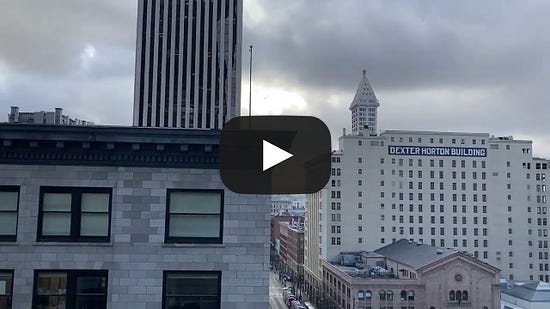Thanks to Mary M.
by David B. Williams (author and son of resident Jackie Williams)
The other day when it was snowing, my wife and I took a short walk from our house. We headed north two blocks, then east over I-5, and up a slight ridge. In doing so, we passed through a phase changing temperature gradient. At our house the snow was not sticking to the sidewalk. At the apex of the ridge, the snow stuck. Total elevation change was about 100 feet.
Depending on which website one trusts, with every 1,000 feet in elevation we could have risen, we would have lost between 3.5 and 5.5 degrees Fahrenheit. Since we ascended only 100 feet, the temperature only dropped between about a third and half a degree, but still just enough of a nanohabitat change to allow snow to remain on pavement.
Several years ago, I also passed through a similar temperature gradient in a downtown building. I had ridden up to the 47th floor of the Seattle Municipal Tower and done a bit of research. When I looked out a nearby window it was snowing but when I got down to the ground floor it was raining. Dropping more than 470 feet, I had gone from snow cold air to rain warm air. It was pretty darned nifty, what you might call urban snow virga, or snirga, if I may coin a portmanteau.
Virga, in which rain doesn’t reach the ground.
The subtle variation we experienced on our walk is one of the challenges in snow forecasting in Seattle. When it snows here, it generally happens right around the freezing point. Combine the mutability of topographic temperatures with our big bodies of water—Lake Washington and Puget Sound—which hold heat longer than pavement and it’s very challenging to provide a definitive snow accumulation forecast for the entire city. So be nice to forecasters, they’re people, too.
But, of course, there’s even more complexity. On our walk snow accumulated in a hodge podge of patterns. The most obvious was the difference between grass and pavement, primarily because grass retains less heat than a sidewalk, and provides a cooler surface where snow can collect. More beautiful was how leaves looked like snow whisperers, as if they had charmed the snow to land only on them. This would be a very wonderful and novel phenomenon but alas has to do with the leaves also providing a cooler surface than the pavement.
Shrubs and trees also play a part. Not surprisingly, less snow accumulated under leafy and well-needled vegetation but the same happened with bare trees. I wonder if, in addition to capturing the snow, the branches changed the flow of air enough to alter accumulation. Considering that I got a 16 percent on a physics test in college, you probably shouldn’t trust any ideas I write that have anything to do with physics.
Proximity to walls also influenced where snow remained. Solar radiation bouncing off south facing walls added enough warmth to sidewalks to keep them bare. There were also many areas with no discernible reason for where snow wasn’t. Were there sewer pipes with warm water heating pavement, geothermal deposits, or not very good snow sweepers?
It looks like the car provided a bit of warmth that kept the sidewalk bare?
So what does all this mean? Some climate change skeptics say that we don’t need to worry about one or two degrees of temperature increase. They are wrong. As I witnessed with the minimal temperature variation I experienced, little is required to alter what happens with snow. In addition, what I saw is predicted to play out in our regional precipitation patterns: climate change induced warming will mean that the mountains of the PNW should get less snow and more rain. Precipitation is expected to rise but because of warming temperatures snow will arrive later in autumn and stop falling earlier in spring. The impacts on salmon, recreation, and urban water supply will be dramatic.
Our planet, our neighborhood, each is sensitive to temperature change. As I walk the streets around my home, I cannot help but be fascinated by the beautiful effects of small variations and worried about the detrimental effects of the big changes we are inflicting on our planet.
Last week I wrote about the old Chamber of Commerce Observatory. Here’s a link to a video I made from another great downtown location with a view. It is the public viewing space on the Seventh Floor Patio of the Fourth and Madison Building, one block north of the former Observatory. The elevator to reach it is in the southwest corner of the main lobby floor, sort of hidden away. Ask at the front desk if you need help.

© 2022 David B. Williams
Seattle, WA 98103



